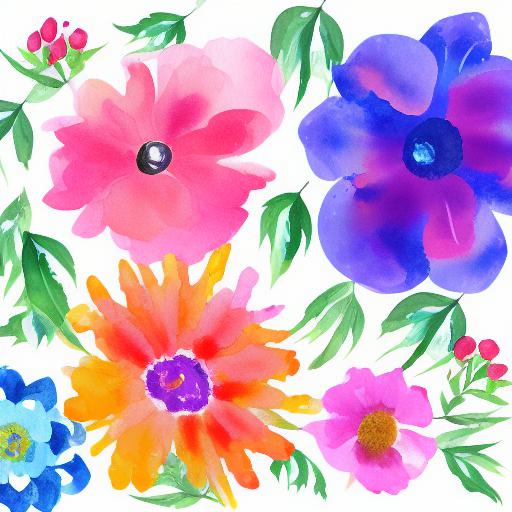About watercolor art
Watercolor flower art is a type of painting that involves using watercolors to create realistic or abstract images of flowers. Watercolor paints are made of pigments suspended in water, and the colors can be blended together on paper to create a range of hues and shades.
One of the benefits of watercolor flower art is the translucent and delicate quality of the colors, which can help to capture the softness and lightness of flowers. The medium is also versatile, allowing for a range of techniques such as wet-on-wet, wet-on-dry, and dry-brush, each of which can create different effects and textures. To create a watercolor flower painting, an artist typically begins with a pencil sketch of the flowers, either from observation or from a photograph. They then apply layers of watercolor paint, building up the colors and textures gradually. Artists may use a range of brush sizes and shapes to create different effects, such as fine details or broad washes of color.
Wide range of styles
Watercolor flower art can be used to create a range of styles and moods, from highly realistic botanical illustrations to loose and expressive abstract pieces. The subject matter of flowers also lends itself well to various artistic themes, such as still life, landscapes, and portraiture.
Watercolor flower art has a long history, dating back to the early days of watercolor painting. It remains a popular and accessible medium for artists of all levels, and its delicate and expressive qualities make it a beloved choice for creating beautiful and timeless floral compositions.
What advantages does creating art through AI algorithms offer?
Utilizing artificial intelligence algorithms to produce art leads to the creation of AI-generated art, which presents several benefits. This includes the ability to generate images quickly and efficiently, as well as experiment with various styles and techniques. Designers can utilize this technology to develop personalized and distinctive designs that meet specific criteria. Additionally, AI-generated art can foster inclusivity by allowing artists from diverse backgrounds to create art that expresses their viewpoints and experiences, leading to increased creativity. To streamline the process further, designers can easily incorporate AI-generated art into their designs using tools such as Visual Paradigm Online.
How to write this prompt?
In the given prompt, the desired image is a watercolor painting of colorful and bright flowers on a white background. The prompt also specifies that the inspiration for the artwork is Esteban Vicente, a renowned artist known for his colorful abstract paintings. The style of the image is described as art nouveau, a decorative style characterized by flowing lines, organic shapes, and intricate details.
The prompt also includes keywords such as “floral,” “flowers,” and “colorful,” which help to guide the algorithm in creating an image that aligns with the desired style and subject matter. By specifying a white background, the prompt creates a contrast that highlights the colors and shapes of the flowers.
The inclusion of Esteban Vicente as the inspiration for the artwork suggests a preference for a particular color palette or artistic style, which the algorithm can use to guide the color choices and brushstrokes. Additionally, mentioning that the image is inspired by a shutterstock contest winner indicates a preference for a style that is popular and has gained recognition from a wider audience.
Overall, the prompt provides a detailed description of the desired image, including the subject matter, style, color palette, and inspiration. These details serve as guidelines for the AI algorithm to create an image that meets the specific requirements outlined in the prompt.


